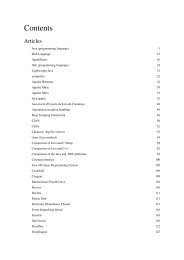Structured Query Language (SQL) - Cultural View of Technology
Structured Query Language (SQL) - Cultural View of Technology
Structured Query Language (SQL) - Cultural View of Technology
You also want an ePaper? Increase the reach of your titles
YUMPU automatically turns print PDFs into web optimized ePapers that Google loves.
Data Definition <strong>Language</strong> 34<br />
The DROP statement is distinct from the DELETE and (non-standard) TRUNCATE statements, in that they do not<br />
remove the table itself. For example, a DELETE statement might delete some (or all) data from a table while leaving<br />
the table itself in the database, whereas a DROP statement would remove the entire table from the database.<br />
ALTER statements<br />
Alter - To modify an existing database object.<br />
An ALTER statement in <strong>SQL</strong> changes the properties <strong>of</strong> an object inside <strong>of</strong> a relational database management system<br />
(RDBMS). The types <strong>of</strong> objects that can be altered depends on which RDBMS is being used.<br />
The typical usage is ALTER objecttype objectname parameters. For example, the command to add (then remove) a<br />
column named bubbles for an existing table named sink would be:<br />
ALTER TABLE sink ADD bubbles INTEGER;<br />
ALTER TABLE sink DROP COLUMN bubbles;<br />
Referential integrity statements<br />
Finally, other kind <strong>of</strong> DDL sentence in <strong>SQL</strong> are the statements to define referential integrity relationships, usually<br />
implemented as primary key and foreign key tags in some columns <strong>of</strong> the tables.<br />
These two statements can be included inside a CREATE TABLE or an ALTER TABLE sentence.<br />
XML Schema<br />
XML Schema is an example <strong>of</strong> a pure DDL (although only relevant in the context <strong>of</strong> XML).<br />
DDL Tools and Related Applications<br />
Apache DdlUtils<br />
Apache DdlUtils [1] is a small, easy-to-use component for working with Database Definition (DDL) files. These are<br />
XML files that contain the definition <strong>of</strong> a database schema, e.g. tables and columns. These files can be fed into<br />
DdlUtils via its Ant task or programmatically in order to create the corresponding database or alter it so that it<br />
corresponds to the DDL. Likewise, DdlUtils can generate a DDL file for an existing database.<br />
See also<br />
• Data Manipulation <strong>Language</strong><br />
• Data Control <strong>Language</strong><br />
References<br />
[1] http://db.apache.org/ddlutils/










